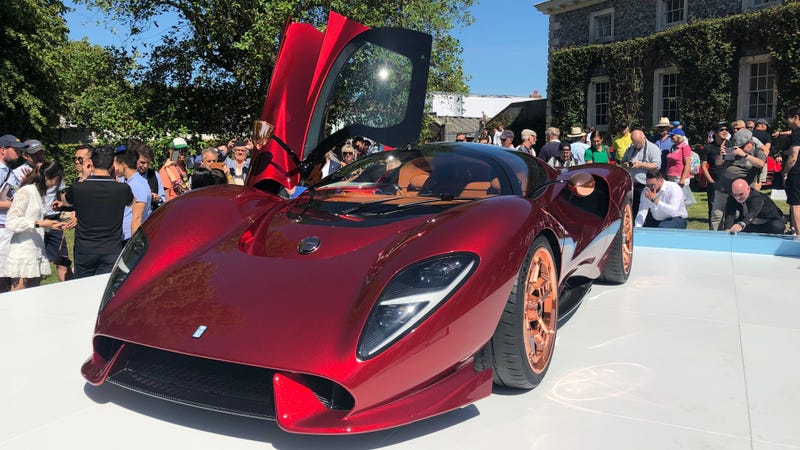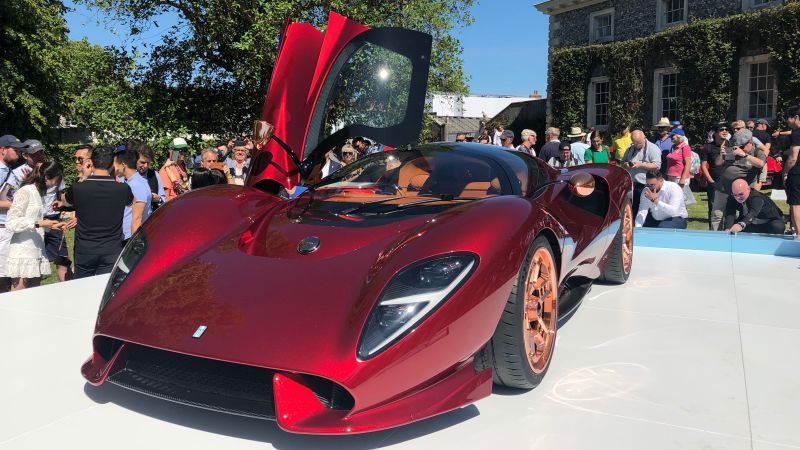
De Tomaso, famed for making the Pantera, is back with the P72—an homage to 1960s prototypes with a modern twist. And like any good homage to old-school racers, it has a manual gearbox.
P72 is a limited run GT, only 72 will be built with a projected base price of EUR750,000 ($846,000). While the cars the inspired it were super hardcore racers, the P72 has been designed to be enjoyed by those who want comfort, but also speed, on the day to day.
The P72 on display is, stick fans, a manual. There are three pedals on the floor, though the final number of gears is as yet unknown.
When news of De Tomaso’s return surfaced coupled with a camo’d up car bearing the legend “#ProjectP” the world assumed a new Pantera was on the way, but that’s not the case. What the firm has released is a GT that shares its chassis with the Apollo IE and has name rooted in De Tomaso’s history.
Advertisement
Rather than launch something out of whack with what’s been before, De Tomaso is looking back in to the less well known chunks of its history. The P72 is based on a little-known prototype racer: P70.
Advertisement

In fact, De Tomaso didn’t know the basis of its first car existed for a while. It admitted as much in the P72’s press release: “Being completely honest, when the brand was acquired we were unaware that this prototype period was part of the De Tomaso heritage. During our studies, endless research both on and offline and speaking to those still around from the brands past a fascinating and untold piece of De Tomaso and Automotive history surfaced.”
Advertisement
The P70 was a collaboration between Alejandro De Tomaso and Carroll Shelby. The idea was, in 1964, that Shelby would bankroll a car to take on the racing elite and De Tomaso would build it. Peter Brock was the man to design it. The P70 would use all of De Tomaso’s engineering knowhow and a new 7.0-liter version of the motor that powered the Cobra, hence the “70.”
However, when Shelby sent Brock to keep an eye on De Tomaso’s work. The latter took umbrage to this, and the two swiftly fell out. Luckily for Shelby, Ford was keen to have him work on it upcoming Ferrari-baiting GT project so we sorted for work. De Tomaso continued working on the car with the coachbuilders at Ghia, and launched it as the Ghia-De Tomaso Sport 5000 at the 1965 Turin Motor Show.
Advertisement

The car is utterly stunning to behold. It was designed by Jowyn Wong, the same man behind the Apollo IE. Rather than create a caricature of its source material, Wong took it in a rather wonderful direction. He took hallmarks from the good ol’ days and created an idealized version of what you imagine when you think of a 1960s prototype.
Advertisement
In his own words: “We intentionally incorporated a distinctive aerodynamically optimized body for performance and to modernize the aesthetics, while the classic wing mirrors and front emblem cap pays homage to the P70.“
The interior takes cues from the 60s and 70s as well, its dials and switchgear are testament to that. It seems as though Pagani may finally have a rival for its interiors.
Advertisement
For the moment De Tomaso isn’t revealing its powertrain specs, however it is worth remembering sister company Apollo’s commitment to natural aspiration.

Advertisement
We do know its chassis is based on the Apollo IE’s, which means it was worked on by HWA (the people behind the Mercedes-Benz CLK GTR) and is FIA safety approved.
De Tomaso is pitching the P72 as a halo car, a statement of intent for what’s going to come in future. There may only be 72 P72s on the road, but that’s not to say more aren’t on the way.
Advertisement
With its parent company owning Apollo, a manufacturer with eyes on creating a modern day GT1 road/race hybrid, it seems De Tomaso will be the motor for the driver that enjoys a more comfortable way of getting around.
Final specs and design will be confirmed in the coming months. For now, just enjoy this pretty thing, and be glad that something like this can exist in this day and age.













